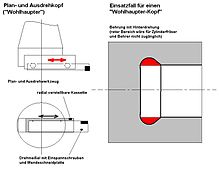Face and boring head
The facing and boring head is a tool that is designed for a milling machine and for boring mills. A distinction is made between the universal facing and boring head (UPA) with manual adjustment for conventional milling and the automatic facing and boring head (APD) for machining centers . It is used for the precise right-angled facing of end faces on bores or the boring of a precise round bore, which can be made with other tools such as milling cutters due to the lack of dimensional accuracy of the tool or the imperfect machine movement when moving around a circle (especially with fitting dimensions with required diameter accuracies of 1/1000 mm) or in the case of an undercut , (i.e. if the front accessible diameter is smaller than the rear, inside, in the hole), cannot be manufactured.
A turning tool is required as a built-in or attached tool to form the cutting edge on the face and boring head. It is screwed or clamped directly to a holder on the face and boring head. This turning tool can be adjusted radially during machining by means of a flat worm gear , whereby a smaller or larger diameter can be set precisely.
Colloquially, the facing and boring head is also known as Wohlhaupter after the company of the same name that invented and marketed this tool in 1937. The acquisition costs of a “Wohlhaupters” are relatively high due to their construction, but compared to the benefits they are quite profitable, since it is a universally adjustable tool, so that many individual tools with fixed dimensions can be replaced.


